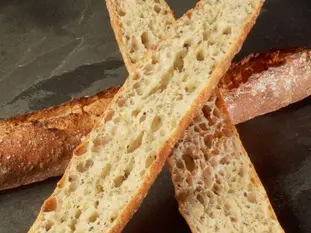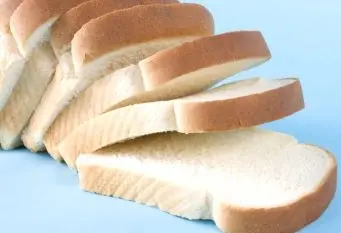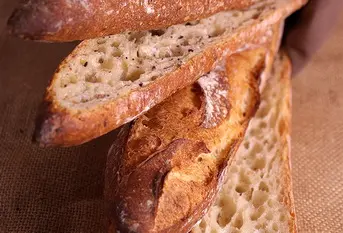This site uses only a few technical cookies necessary for its operation. By continuing to browse, you accept their use.
To find out more...
To find out more...
The color of the bread crumb

When you go to buy bread, at your baker's, at the time of the choice, if you hesitate of course, you will undoubtedly be very sensitive to the color of the crust, and you will be right.
The color of the crust, from golden, to sometimes very dark, deep brown almost black, depending on the maturity of the baking and the flours used, is an excellent indicator of the future taste of the bread, because it concentrates alone 80% of what makes this taste.
The crumb comes a little later, but its color is also an excellent indicator of the work of the baker, here are some explanations on this color.
The color of the crust, from golden, to sometimes very dark, deep brown almost black, depending on the maturity of the baking and the flours used, is an excellent indicator of the future taste of the bread, because it concentrates alone 80% of what makes this taste.
The crumb comes a little later, but its color is also an excellent indicator of the work of the baker, here are some explanations on this color.
21 K 4.6/5 (19 reviews)
Keywords for this post:BreadCrustCrumbColoringTasteQualityCreamLast modified on: April 30th 2022
The color of the bread crumb
I have already told you several times (it is a subject that is very dear to me), bread is: flour, water, salt and a drop of baker's yeast or sourdough, and that's all!
To make bread, the baker uses a baker's flour, which seems white at first glance but which in fact contains a small part of the wheat bran. The T is then 55 or 65.
This is what differentiates bakery flours from pastry flours, which are purer, whiter, T45.
Once these ingredients are mixed, the baker starts the kneading, more or less long, more or less fast, to make the bread dough.
If he wants to obtain the whitest bread possible, he will knead for a long time and especially fast, we call it intensive kneading, so during this kneading, air will be incorporated into the dough, which will make it whiten.
The problem is that this way of doing things is to the detriment of the taste of the bread, the more it is "white" the less it tastes, the archetype of this kind of bread is the industrial sandwich bread, certainly very soft, but completely bland and moreover stuffed with all kinds of vile additives, which make that by reading the list of ingredients, one wonders if it is really still bread.
On the other hand, if the baker kneads a little and at low speed, the crumb will not be white, it will be a little bit "creamy" or light grey, which is a very good thing because it will have much more taste.
And if he combines this short kneading with a long, or even very long rest (24 hours is not a problem) of the dough, he could offer you an excellent bread.
All this to tell you that a bread with a white crumb, tragic heritage of the 70's and industrialization in France, where bakers switched to white bread that their customers asked them (often for bad memories of black bread during the war), a bread with a white crumb is not a guarantee of quality, on the contrary, the more the crumb is white the less your bread has taste, in general.
On the contrary, the more the crumb is white, the less taste your bread has, in general. On the other hand, breads with a "cream" or "beige" crumb, sometimes almost yellow, are a guarantee of quality and the assurance, almost for sure, to have a bread with a crumb full of taste, which will allow you, among other things, to "saucer" perfectly.
By the way, this word "saucer", so classic for us French, makes our English speaking friends laugh once they understand what it means: You French are capable of inventing words just for a small gesture of greed!
Yes, indeed...
To sum up: The color of the crumb is a good indicator of its future taste, the whiter it is the more neutral (or bland) it is, the more "creamy" or "kissy" it is, the result of a slow and short kneading, the more taste it has.
To make bread, the baker uses a baker's flour, which seems white at first glance but which in fact contains a small part of the wheat bran. The T is then 55 or 65.
This is what differentiates bakery flours from pastry flours, which are purer, whiter, T45.
Once these ingredients are mixed, the baker starts the kneading, more or less long, more or less fast, to make the bread dough.
If he wants to obtain the whitest bread possible, he will knead for a long time and especially fast, we call it intensive kneading, so during this kneading, air will be incorporated into the dough, which will make it whiten.

The problem is that this way of doing things is to the detriment of the taste of the bread, the more it is "white" the less it tastes, the archetype of this kind of bread is the industrial sandwich bread, certainly very soft, but completely bland and moreover stuffed with all kinds of vile additives, which make that by reading the list of ingredients, one wonders if it is really still bread.

On the other hand, if the baker kneads a little and at low speed, the crumb will not be white, it will be a little bit "creamy" or light grey, which is a very good thing because it will have much more taste.
And if he combines this short kneading with a long, or even very long rest (24 hours is not a problem) of the dough, he could offer you an excellent bread.

All this to tell you that a bread with a white crumb, tragic heritage of the 70's and industrialization in France, where bakers switched to white bread that their customers asked them (often for bad memories of black bread during the war), a bread with a white crumb is not a guarantee of quality, on the contrary, the more the crumb is white the less your bread has taste, in general.
On the contrary, the more the crumb is white, the less taste your bread has, in general. On the other hand, breads with a "cream" or "beige" crumb, sometimes almost yellow, are a guarantee of quality and the assurance, almost for sure, to have a bread with a crumb full of taste, which will allow you, among other things, to "saucer" perfectly.
By the way, this word "saucer", so classic for us French, makes our English speaking friends laugh once they understand what it means: You French are capable of inventing words just for a small gesture of greed!
Yes, indeed...
To sum up: The color of the crumb is a good indicator of its future taste, the whiter it is the more neutral (or bland) it is, the more "creamy" or "kissy" it is, the result of a slow and short kneading, the more taste it has.
Lasts posts
Butter vs. grease
We often read in a recipe where a pastry is put into a mould that, just before pouring, the mould should be buttered or greased. But what's the difference between these 2 terms?December 1st 20251,1885
Getting out of the fridge early
Very often when you're cooking, you need to take food or preparations out of the fridge, to use them in the recipe in progress. There's nothing tricky about this: you just take them out of the fridge and use them, usually immediately, in the recipe. But is this really a good method?November 24th 20251,2025
Who's making the croissants?
When you look at a bakery from the outside, you naturally think that in the bakery, the bakers make the bread, and in the laboratory, the pastry chefs make the cakes. It's very often like that, with each of these professions having quite different ways of working, but sometimes there's also one...November 23th 20251,100
Oven height
When we put a dish or cake in the oven, we naturally tend to put it on the middle shelf, and that's what we usually do. But in some cases, this position and height can be a little tricky, so let's find out why.October 8th 20252,9805
The importance of sieving
In recipes that use a fine powder (flour, powdered sugar, etc.), you'll often see the advice to sift before using it. To sift is to pass the powder in question through a sieve (a very fine strainer) before incorporating it into your recipe. It's often advice, but is it really useful?September 3rd 20257,6913
Other pages you may also like
The so-called "nervous" meats
You've probably heard this before, we're talking about "nervous" meat, or meat with nerves, to describe what is indicated by the blue arrow on the left. This is a piece of beef, and what we call a nerve is not a nerve, it is in fact collagen (chemists sometimes call it a "collagen sink"), a...April 16th 202137 K4.5
What is the difference between bakery and patisserie?
This is a question that you may well have asked yourself and which I will attempt to answer. In France the two trades of "boulangerie" (bakery) and "pâtisserie" (patisserie and confectionery) have always been quite distinct, but where exactly do the boundaries lie? .February 7th 2017134 K 14.1
Candied fruits: don't get ripped off
Do you like candied fruit? You might like to nibble a handful or add it to a recipe, like a classic fruit cake or delicious Italian specialities like panettone or sicilian epiphany pie.June 21th 201767 K 24.2
A few tips for effective kneading at home
When you have to knead dough for bread or some other recipe, you may well use a food processor or the type of machine known as a stand mixer. The best-known brands are Kenwood and KitchenAid. They are useful tools, but here are a few tips to help you get the best out of them.June 23th 2021284 K 23.8
Egg yolks and caster sugar
We often come across recipes where we need to mix egg yolks with caster sugar. This would appear to be a very ordinary and simple thing to do but, be warned, these two ingredients can behave oddly together.February 15th 201883 K 24.3
Post a comment or question
Follow this page
If you are interested in this page, you can "follow" it, by entering your email address here. You will then receive a notification immediately each time the page is modified or a new comment is added. Please note that you will need to confirm this following.
Note: We'll never share your e-mail address with anyone else.
Alternatively: you can subscribe to the mailing list of cooling-ez.com , you will receive a e-mail for each new recipe published on the site.









